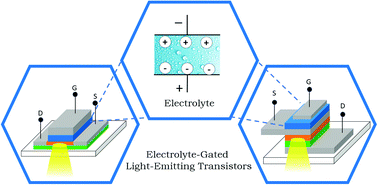Electrolyte-gated light-emitting transistors: working principle and applications
Abstract
Adding solid electrolytes into organic semiconductors broadens the scope of material properties and electronic applications. Successful examples include polymer light-emitting electrochemical cells, electrolyte-gated organic transistors, and electrolyte-gated organic light-emitting transistors (EGLETs). EGLETs combine an organic light-emitting device and a transistor with a high capacitance electrolytic dielectric. Here we summarize recent progress in the development of EGLETs in both planar and vertical device architectures. The former offers a lateral geometry and in-plane light-emission for scientific scaffolds in the fundamental study of organic semiconductor opto-physics. The latter features surface emission with a unity aperture ratio, and it can be used in matrix displays without the requirement of external thin-film transistor arrays as the switching circuitry. This strategy paves an easy avenue towards fabricating highly integrated organic optoelectronic devices, and it offers a new test bed for research in iontronics and organic electronics.

- This article is part of the themed collections: 2018 Materials Chemistry Frontiers Review-type Articles and Molecular Materials and Devices


 Please wait while we load your content...
Please wait while we load your content...